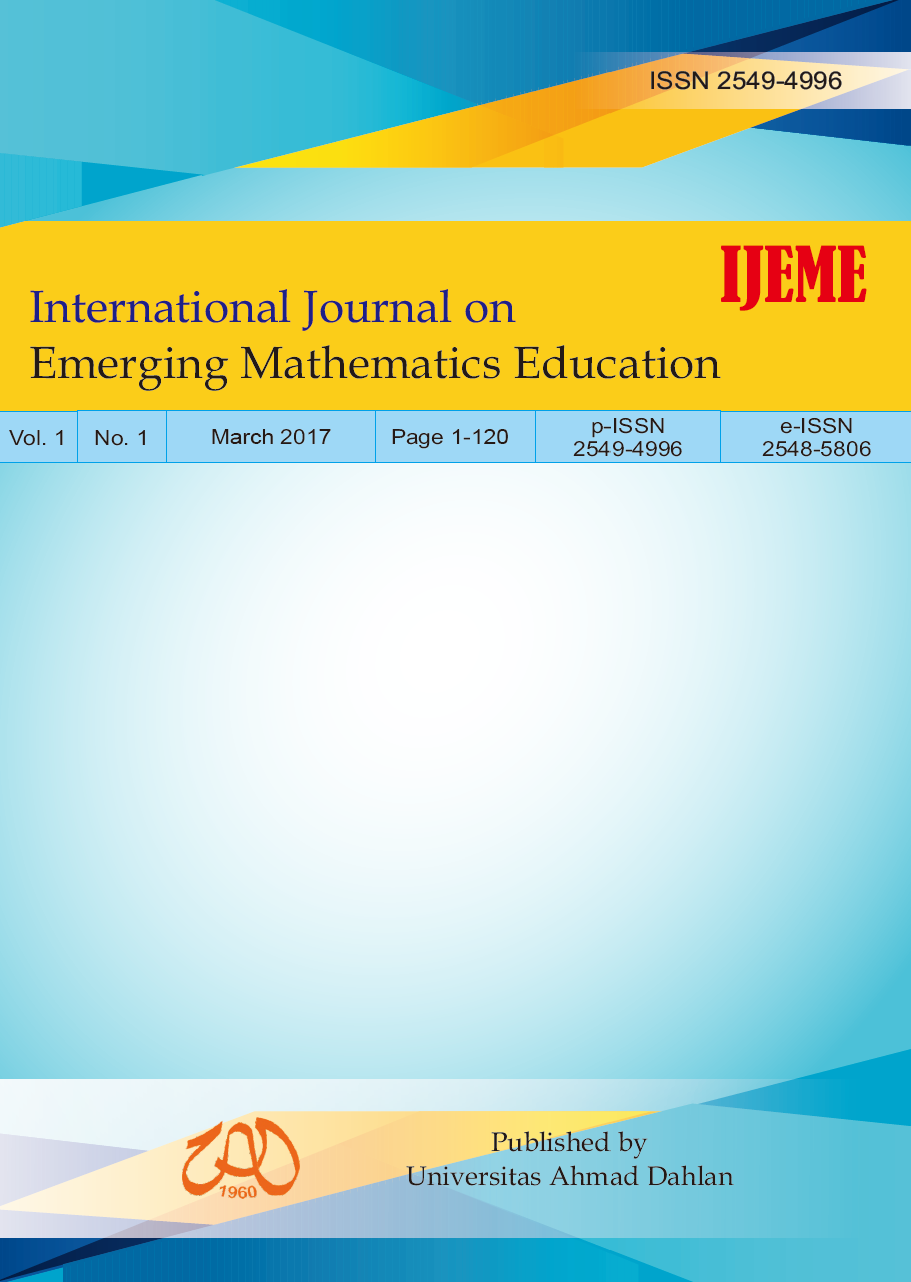Teachers' Real and Perceived of ICTs Supported-Situation for Mathematics Teaching and Learning
DOI:
https://doi.org/10.12928/ijeme.v1i1.5695Keywords:
survey, technology-based learning, ict, infrastructure, facilities, resourcesAbstract
Purpose of this research was to gain information related to the real and perceived ICT Infrastructures, Facilities, and Resources in Bojonegara Sub District, Indonesia. This article emphasize the publication of this information because it is needed for implementation of technology-based mathematics teaching and learning. The method used was survey. Instruments of survey were questionnaires, unstructured interview guideline, and handycam. During the survey, total of 220 questionnaire packages were distributed to teachers, however only 119 (response rate 54.1%) of them were filled and returned. A total of 12 teachers were interviewed, with five of these interviews were video recorded. Several head masters welcomed and allowed researcher to visit their schools and make documentation of ICT Infrastructures, facilities, and resources, while the others did not allow the researcher to do that. Based on survey, many important findings have been discovered. It is suggested that the Teachers-Centered Learning with Technology is the most appropriate method of technology-based learning to be implemented.References
Agostinho, S. (2009). Learning Design Representations to Document, Model, and Share Teaching Practice. In Lockyer, L., et al. (2009). Handbook of Research on Learning Design and Learning Objects; Issues, Application, and Technologies. Vol. 1. New York: Information Science Reference.
De Vaus, D., A. (2002). Surveys in Social Research (5th Edition). Crows Nest: Allen & Unwin.
Fathurrohman, M., & Porter, A. (2012). Addressing the needs of a developing nation: electronic maps of mathematical learning resources accessible via the internet. Journal of Computers in Mathematics and Science Teaching, 31(4), 337-362.
Fathurrohman, M., Porter, A., & Worthy, A., L. (2014). Comparison of performance due to guided hyperlearning, unguided hyperlearning, and conventional learning in mathematics: an empirical study. International Journal of Mathematical Education in Science and Technology, 45(5), 682-692.
InfoDev. (2007). Survey of ICT for Education in Africa. World Bank.
InfoDev. (2009a). Survey of ICT for Education in Caribbean. World Bank.
InfoDev. (2009b). Various Country Study Reports and Case Study Working Papers (Argentina, Brazil, Kenya, Korea, Morocco, Nigeria, Philippines, Peru, Senegal, Sudan, Tunisia, Uganda, and Vietnam) in regard to technology and or education. World Bank.
InfoDev. (2010). Survey of ICT for Education in India and South Asia Countries. World Bank.
International Development Research Centre. (2010). Digital Review of Asia Pacific.
Oxford Dictionaries. (2011). Available at: http://oxforddictionaries.com/
Ross, T.W., & Bailey, G.D. (1995). Technology-Based Learning; A Handbook for Principals and Technology Leaders. New York: Scholastic Inc.
World Economic Forum. (2016). The Global Competitiveness Report. Geneva.
Downloads
Published
How to Cite
Issue
Section
License
License and Copyright Agreement
In submitting the manuscript to the journal, the authors certify that:
- They are authorized by their co-authors to enter into these arrangements.
- The work described has not been formally published before, except in the form of an abstract or as part of a published lecture, review, thesis, or overlay journal. Please also carefully read the International Journal on Emerging Mathematics Education (IJEME) Author Guidelines at http://journal.uad.ac.id/index.php/IJEME/about/submissions#authorGuidelines
- That it is not under consideration for publication elsewhere,
- That its publication has been approved by all the author(s) and by the responsible authorities, tacitly or explicitly, of the institutes where the work has been carried out.
- They secure the right to reproduce any material that has already been published or copyrighted elsewhere.
- They agree to the following license and copyright agreement.
Copyright
Authors who publish with the International Journal on Emerging Mathematics Education (IJEME) agree to the following terms:
- Authors retain copyright and grant the journal the right of first publication with the work simultaneously licensed under a Creative Commons Attribution License (CC BY-SA 4.0) that allows others to share the work with an acknowledgment of the work's authorship and initial publication in this journal.
- Authors are able to enter into separate, additional contractual arrangements for the non-exclusive distribution of the journal's published version of the work (e.g., post it to an institutional repository or publish it in a book), with an acknowledgment of its initial publication in this journal.
- Authors are permitted and encouraged to post their work online (e.g., in institutional repositories or on their website) prior to and during the submission process, as it can lead to productive exchanges, as well as earlier and greater citation of published work.
![]()
Ciptaan disebarluaskan di bawah Lisensi Creative Commons Atribusi-BerbagiSerupa 4.0 Internasional.





